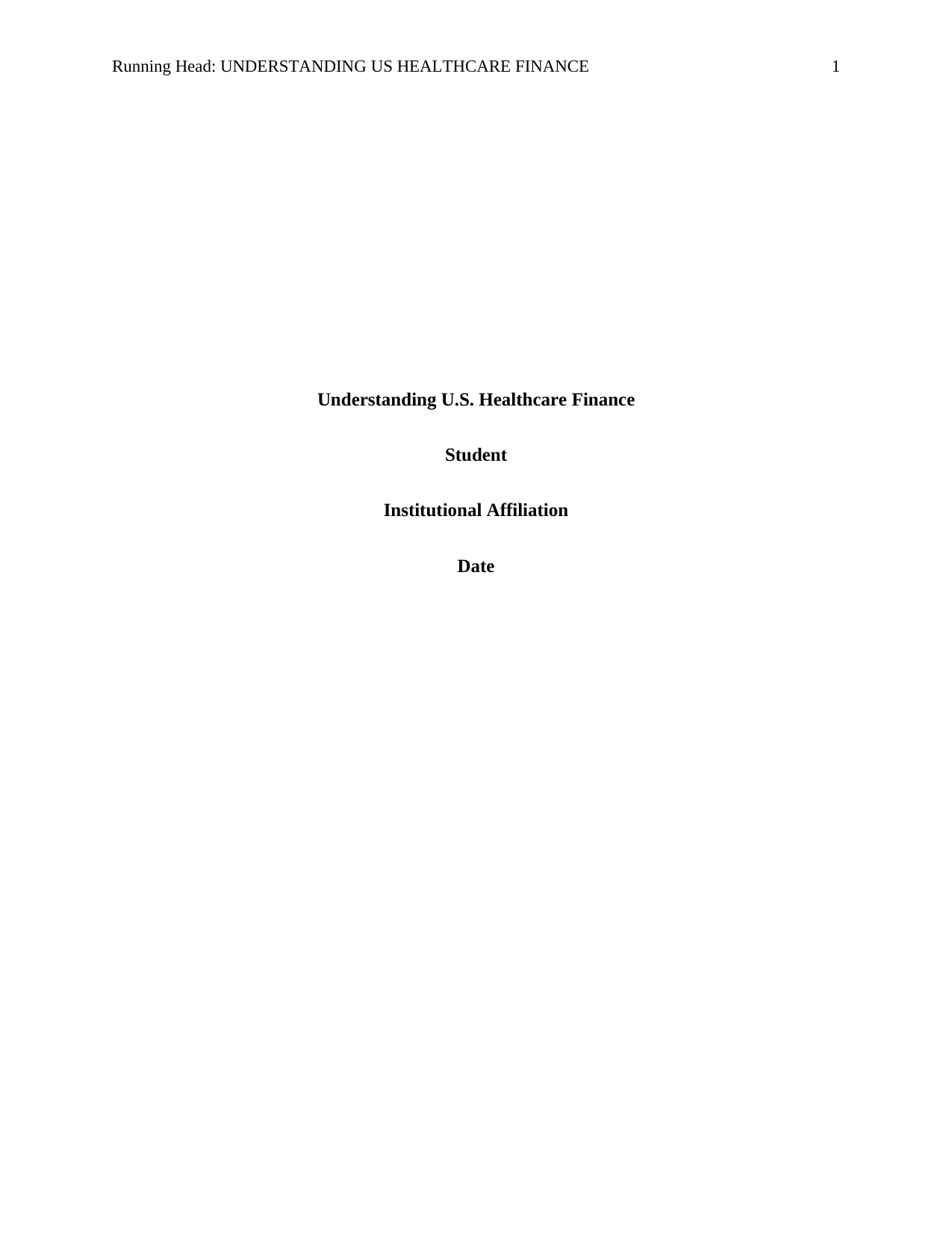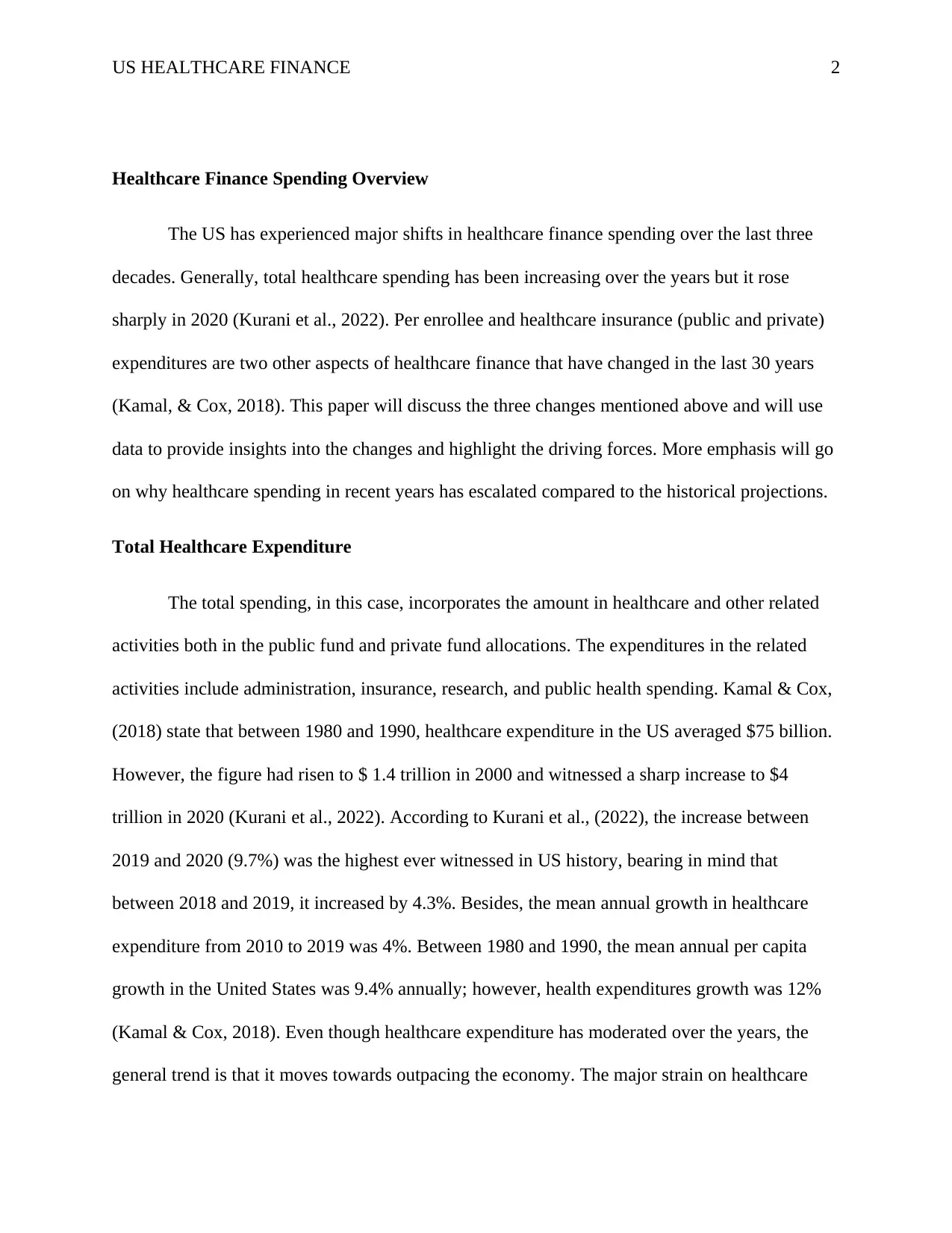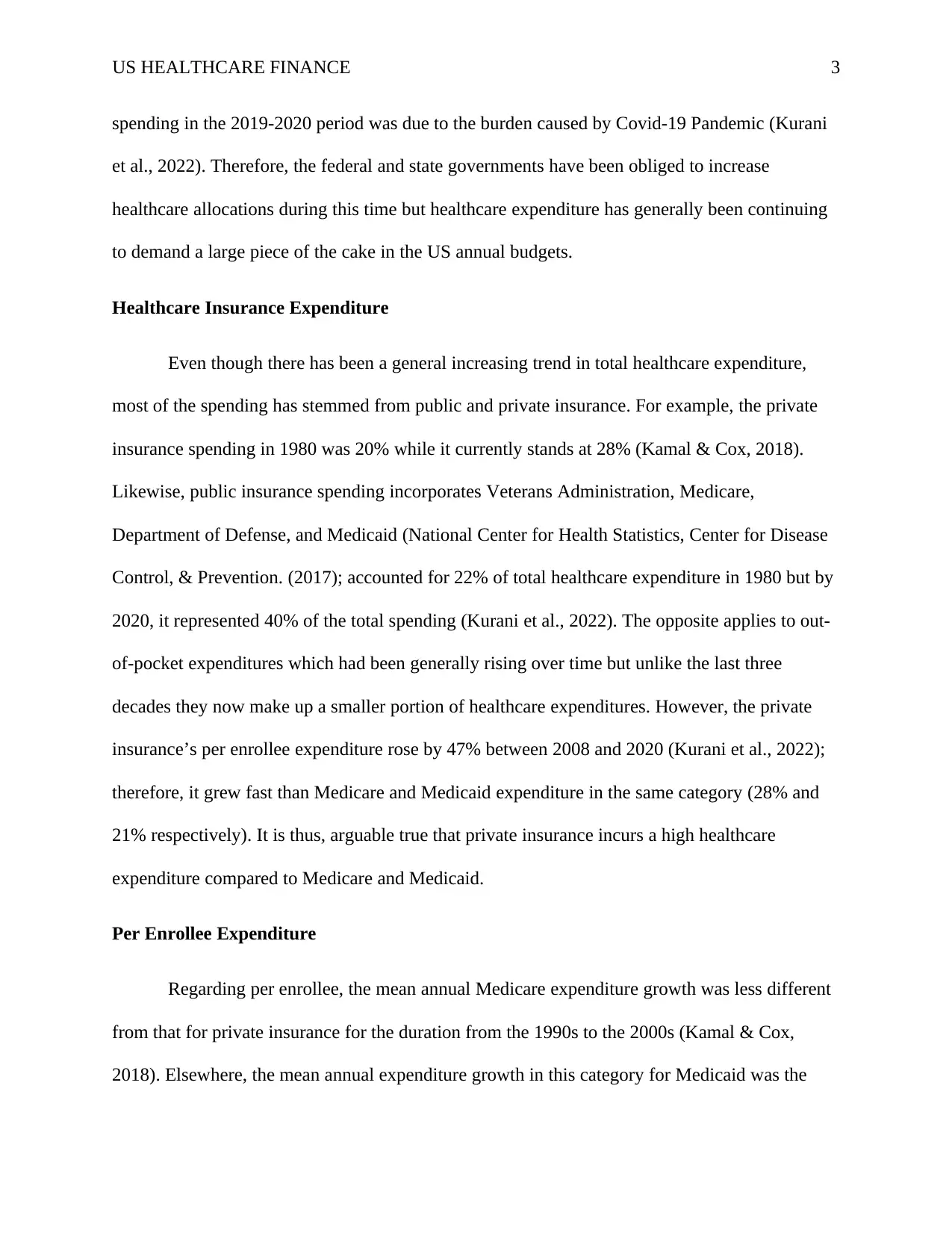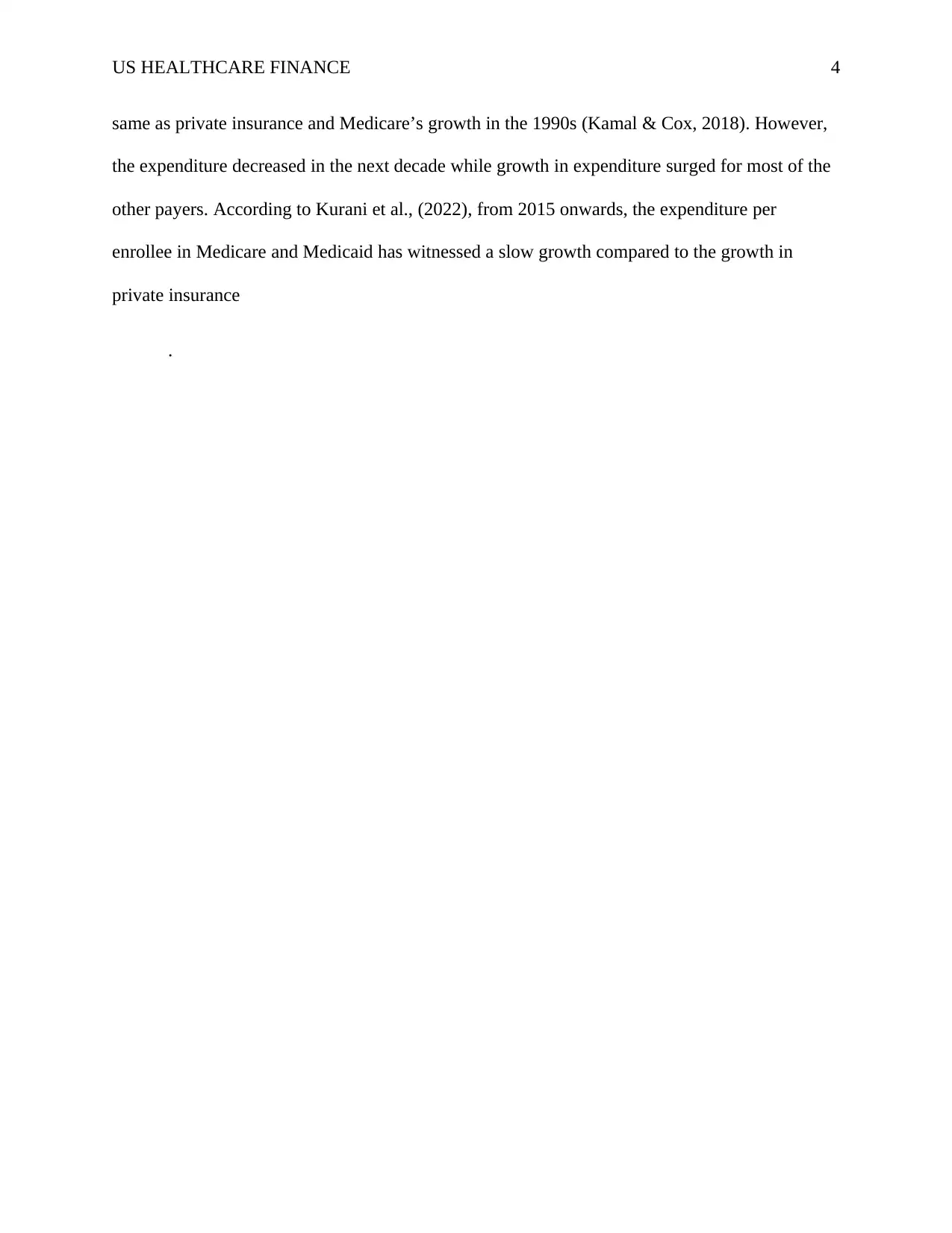A Comprehensive Report on US Healthcare Finance Expenditures
VerifiedAdded on 2022/07/20
|5
|886
|53
Report
AI Summary
This report provides an in-depth analysis of US healthcare finance, examining the major shifts in spending over the past three decades. It focuses on total healthcare expenditure, detailing the rise in spending from 1980 to 2020, with an emphasis on the sharp increase in 2020 due to the COVID-19 pandemic. The report also explores healthcare insurance expenditure, comparing private and public insurance spending trends, and highlighting the increasing share of total healthcare expenditure attributed to both. Furthermore, the report analyzes per enrollee expenditure, comparing the growth rates of Medicare, Medicaid, and private insurance. The analysis uses data to provide insights into the driving forces behind these changes, offering a comprehensive overview of the US healthcare finance landscape and its evolution.

Running Head: UNDERSTANDING US HEALTHCARE FINANCE 1
Understanding U.S. Healthcare Finance
Student
Institutional Affiliation
Date
Understanding U.S. Healthcare Finance
Student
Institutional Affiliation
Date
Paraphrase This Document
Need a fresh take? Get an instant paraphrase of this document with our AI Paraphraser

US HEALTHCARE FINANCE 2
Healthcare Finance Spending Overview
The US has experienced major shifts in healthcare finance spending over the last three
decades. Generally, total healthcare spending has been increasing over the years but it rose
sharply in 2020 (Kurani et al., 2022). Per enrollee and healthcare insurance (public and private)
expenditures are two other aspects of healthcare finance that have changed in the last 30 years
(Kamal, & Cox, 2018). This paper will discuss the three changes mentioned above and will use
data to provide insights into the changes and highlight the driving forces. More emphasis will go
on why healthcare spending in recent years has escalated compared to the historical projections.
Total Healthcare Expenditure
The total spending, in this case, incorporates the amount in healthcare and other related
activities both in the public fund and private fund allocations. The expenditures in the related
activities include administration, insurance, research, and public health spending. Kamal & Cox,
(2018) state that between 1980 and 1990, healthcare expenditure in the US averaged $75 billion.
However, the figure had risen to $ 1.4 trillion in 2000 and witnessed a sharp increase to $4
trillion in 2020 (Kurani et al., 2022). According to Kurani et al., (2022), the increase between
2019 and 2020 (9.7%) was the highest ever witnessed in US history, bearing in mind that
between 2018 and 2019, it increased by 4.3%. Besides, the mean annual growth in healthcare
expenditure from 2010 to 2019 was 4%. Between 1980 and 1990, the mean annual per capita
growth in the United States was 9.4% annually; however, health expenditures growth was 12%
(Kamal & Cox, 2018). Even though healthcare expenditure has moderated over the years, the
general trend is that it moves towards outpacing the economy. The major strain on healthcare
Healthcare Finance Spending Overview
The US has experienced major shifts in healthcare finance spending over the last three
decades. Generally, total healthcare spending has been increasing over the years but it rose
sharply in 2020 (Kurani et al., 2022). Per enrollee and healthcare insurance (public and private)
expenditures are two other aspects of healthcare finance that have changed in the last 30 years
(Kamal, & Cox, 2018). This paper will discuss the three changes mentioned above and will use
data to provide insights into the changes and highlight the driving forces. More emphasis will go
on why healthcare spending in recent years has escalated compared to the historical projections.
Total Healthcare Expenditure
The total spending, in this case, incorporates the amount in healthcare and other related
activities both in the public fund and private fund allocations. The expenditures in the related
activities include administration, insurance, research, and public health spending. Kamal & Cox,
(2018) state that between 1980 and 1990, healthcare expenditure in the US averaged $75 billion.
However, the figure had risen to $ 1.4 trillion in 2000 and witnessed a sharp increase to $4
trillion in 2020 (Kurani et al., 2022). According to Kurani et al., (2022), the increase between
2019 and 2020 (9.7%) was the highest ever witnessed in US history, bearing in mind that
between 2018 and 2019, it increased by 4.3%. Besides, the mean annual growth in healthcare
expenditure from 2010 to 2019 was 4%. Between 1980 and 1990, the mean annual per capita
growth in the United States was 9.4% annually; however, health expenditures growth was 12%
(Kamal & Cox, 2018). Even though healthcare expenditure has moderated over the years, the
general trend is that it moves towards outpacing the economy. The major strain on healthcare

US HEALTHCARE FINANCE 3
spending in the 2019-2020 period was due to the burden caused by Covid-19 Pandemic (Kurani
et al., 2022). Therefore, the federal and state governments have been obliged to increase
healthcare allocations during this time but healthcare expenditure has generally been continuing
to demand a large piece of the cake in the US annual budgets.
Healthcare Insurance Expenditure
Even though there has been a general increasing trend in total healthcare expenditure,
most of the spending has stemmed from public and private insurance. For example, the private
insurance spending in 1980 was 20% while it currently stands at 28% (Kamal & Cox, 2018).
Likewise, public insurance spending incorporates Veterans Administration, Medicare,
Department of Defense, and Medicaid (National Center for Health Statistics, Center for Disease
Control, & Prevention. (2017); accounted for 22% of total healthcare expenditure in 1980 but by
2020, it represented 40% of the total spending (Kurani et al., 2022). The opposite applies to out-
of-pocket expenditures which had been generally rising over time but unlike the last three
decades they now make up a smaller portion of healthcare expenditures. However, the private
insurance’s per enrollee expenditure rose by 47% between 2008 and 2020 (Kurani et al., 2022);
therefore, it grew fast than Medicare and Medicaid expenditure in the same category (28% and
21% respectively). It is thus, arguable true that private insurance incurs a high healthcare
expenditure compared to Medicare and Medicaid.
Per Enrollee Expenditure
Regarding per enrollee, the mean annual Medicare expenditure growth was less different
from that for private insurance for the duration from the 1990s to the 2000s (Kamal & Cox,
2018). Elsewhere, the mean annual expenditure growth in this category for Medicaid was the
spending in the 2019-2020 period was due to the burden caused by Covid-19 Pandemic (Kurani
et al., 2022). Therefore, the federal and state governments have been obliged to increase
healthcare allocations during this time but healthcare expenditure has generally been continuing
to demand a large piece of the cake in the US annual budgets.
Healthcare Insurance Expenditure
Even though there has been a general increasing trend in total healthcare expenditure,
most of the spending has stemmed from public and private insurance. For example, the private
insurance spending in 1980 was 20% while it currently stands at 28% (Kamal & Cox, 2018).
Likewise, public insurance spending incorporates Veterans Administration, Medicare,
Department of Defense, and Medicaid (National Center for Health Statistics, Center for Disease
Control, & Prevention. (2017); accounted for 22% of total healthcare expenditure in 1980 but by
2020, it represented 40% of the total spending (Kurani et al., 2022). The opposite applies to out-
of-pocket expenditures which had been generally rising over time but unlike the last three
decades they now make up a smaller portion of healthcare expenditures. However, the private
insurance’s per enrollee expenditure rose by 47% between 2008 and 2020 (Kurani et al., 2022);
therefore, it grew fast than Medicare and Medicaid expenditure in the same category (28% and
21% respectively). It is thus, arguable true that private insurance incurs a high healthcare
expenditure compared to Medicare and Medicaid.
Per Enrollee Expenditure
Regarding per enrollee, the mean annual Medicare expenditure growth was less different
from that for private insurance for the duration from the 1990s to the 2000s (Kamal & Cox,
2018). Elsewhere, the mean annual expenditure growth in this category for Medicaid was the
⊘ This is a preview!⊘
Do you want full access?
Subscribe today to unlock all pages.

Trusted by 1+ million students worldwide

US HEALTHCARE FINANCE 4
same as private insurance and Medicare’s growth in the 1990s (Kamal & Cox, 2018). However,
the expenditure decreased in the next decade while growth in expenditure surged for most of the
other payers. According to Kurani et al., (2022), from 2015 onwards, the expenditure per
enrollee in Medicare and Medicaid has witnessed a slow growth compared to the growth in
private insurance
.
same as private insurance and Medicare’s growth in the 1990s (Kamal & Cox, 2018). However,
the expenditure decreased in the next decade while growth in expenditure surged for most of the
other payers. According to Kurani et al., (2022), from 2015 onwards, the expenditure per
enrollee in Medicare and Medicaid has witnessed a slow growth compared to the growth in
private insurance
.
Paraphrase This Document
Need a fresh take? Get an instant paraphrase of this document with our AI Paraphraser

US HEALTHCARE FINANCE 5
References
Kamal, R., & Cox, C. (2018). How has US spending on healthcare changed over time. Peterson
KFF-Health System Tracker. Disponívelem:.Acessoem, 5.
Kurani, N., Ortaliza, J., Wager, E., Fox, L., & Amin, K. (2022). How has US spending on
healthcare changed over time. Peterson-KFF health system tracker.
National Center for Health Statistics, Center For Disease Control, & Prevention. (2017). Health,
United States, 2016, with chartbook on Long-term trends in health.
References
Kamal, R., & Cox, C. (2018). How has US spending on healthcare changed over time. Peterson
KFF-Health System Tracker. Disponívelem:.Acessoem, 5.
Kurani, N., Ortaliza, J., Wager, E., Fox, L., & Amin, K. (2022). How has US spending on
healthcare changed over time. Peterson-KFF health system tracker.
National Center for Health Statistics, Center For Disease Control, & Prevention. (2017). Health,
United States, 2016, with chartbook on Long-term trends in health.
1 out of 5
Related Documents
Your All-in-One AI-Powered Toolkit for Academic Success.
+13062052269
info@desklib.com
Available 24*7 on WhatsApp / Email
![[object Object]](/_next/static/media/star-bottom.7253800d.svg)
Unlock your academic potential
Copyright © 2020–2025 A2Z Services. All Rights Reserved. Developed and managed by ZUCOL.




